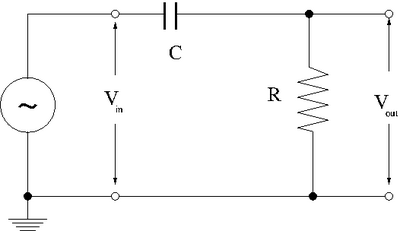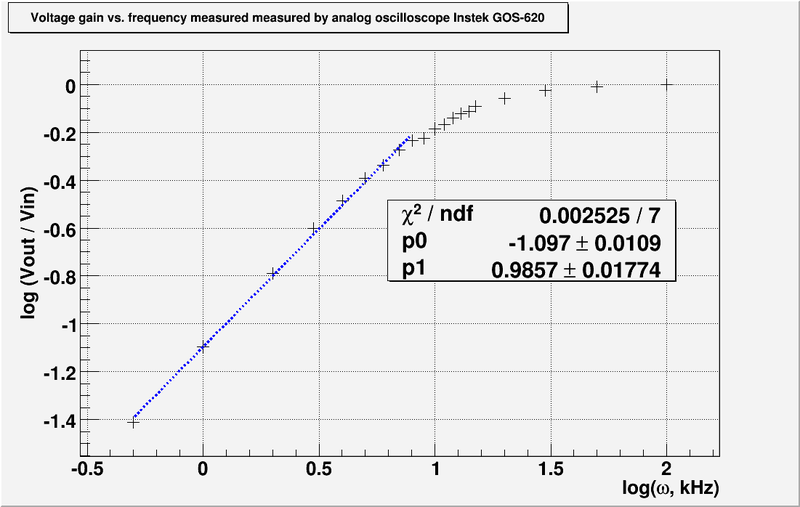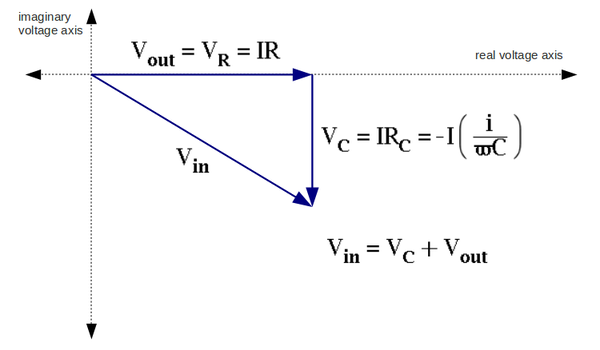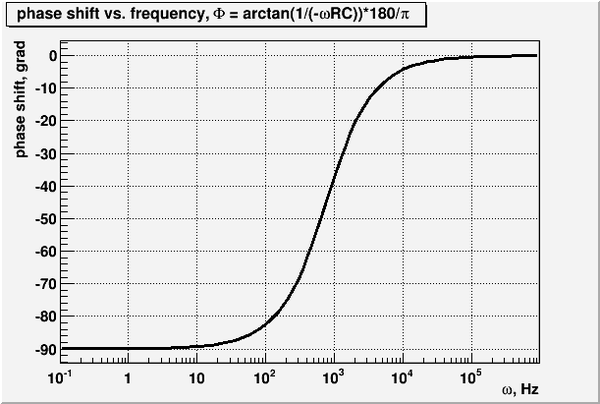Difference between revisions of "Lab 4 RS"
| Line 93: | Line 93: | ||
Theoretical break frequency: <math>12.13\ \mbox{kHz}</math> | Theoretical break frequency: <math>12.13\ \mbox{kHz}</math> | ||
| − | The fit line equation from the plot above is <math>\ y=-1. | + | The fit line equation from the plot above is <math>\ y=-1.097+0.9857\cdot x</math>. |
From intersection point of line with x-axis we find: | From intersection point of line with x-axis we find: | ||
| − | :<math>\mbox{log}(f_{exper})=\frac{1. | + | :<math>\mbox{log}(f_{exper})=\frac{1.097}{0.9857} = 1.113</math> |
| − | :<math>f_{exp} = 10^{1. | + | :<math>f_{exp} = 10^{1.113} = 12.97\ \mbox{kHz} </math> |
The error is: | The error is: | ||
| − | <math>Error = \left| \frac{f_{exp} - f_{theor}}{f_{theor}} \right| = \left| \frac{ | + | <math>Error = \left| \frac{f_{exp} - f_{theor}}{f_{theor}} \right| = \left| \frac{12.97 - 12.13}{12.13} \right|= 6.92\ %</math> |
Error is pretty big. Probably is something wrong with RC measurements. | Error is pretty big. Probably is something wrong with RC measurements. | ||
Revision as of 23:47, 27 January 2011
- RC High-pass filter
1-50 kHz filter (20 pnts)
1. Design a high-pass RC filter with a break point between 1-50 kHz. The break point is the frequency at which the filter's attenuation of the AC signal goes to 0(not passed). For a High pass filter, AC signals with a frequency below the 1-50 kHz range will be attenuated .
- To design low-pass RC filter I had:
So
2. Now construct the circuit using a non-polar capacitor.
3. Use a sinusoidal variable frequency oscillator to provide an input voltage to your filter.
4. Measure the input and output voltages for at least 8 different frequencies which span the frequency range from 1 Hz to 1 MHz.
| 0.1 | |||
| 1.0 | |||
| 2.0 | |||
| 3.0 | |||
| 4.0 | |||
| 5.0 | |||
| 6.0 | |||
| 7.0 | |||
| 8.0 | |||
| 9.0 | |||
| 10.0 | |||
| 11.0 | |||
| 12.0 | |||
| 15.0 | |||
| 20.0 | |||
| 30.0 | |||
| 40.0 | |||
| 50.0 | |||
| 100.0 | |||
| 200.0 |
5. Graph the -vs-
phase shift (10 pnts)
- measure the phase shift between and as a function of frequency . Hint: you could use as an external trigger and measure the time until reaches a max on the scope .
See question 3 about my phase shift measurements
Questions
1. Compare the theoretical and experimentally measured break frequencies. (5 pnts)
Theoretical break frequency:
The fit line equation from the plot above is . From intersection point of line with x-axis we find:
The error is:
Error is pretty big. Probably is something wrong with RC measurements.
2. Calculate and expression for as a function of , , and .(5 pnts)
We have:
Dividing second equation into first one we get the voltage gain:
And we are need the real part:
3. Compare the theoretical and experimental value for the phase shift . (5 pnts)
The experimental phase shift is
The theoretical phase shift is
4. Sketch the phasor diagram for ,, , and . Put the current along the real voltage axis. (30 pnts)
5. What is the phase shift for a DC input and a very-high frequency input?(5 pnts)
Because a DC circuit doesn't have any oscillation there are no any phase shift.
6. Calculate and expression for the phase shift as a function of , , and graph -vs . (20 pnts)
From the phasor diagram above (question 4) the angle between vectors and given by
Forest_Electronic_Instrumentation_and_Measurement Go Back to All Lab Reports



